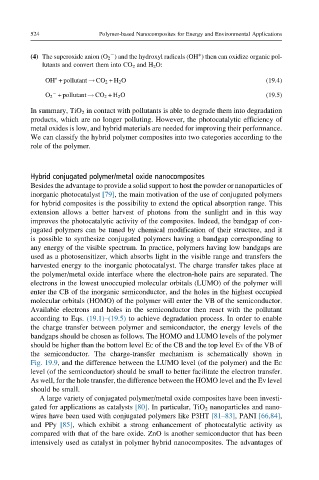Page 571 - Polymer-based Nanocomposites for Energy and Environmental Applications
P. 571
524 Polymer-based Nanocomposites for Energy and Environmental Applications
(4) The superoxide anion (O 2 ) and the hydroxyl radicals (OH*) then can oxidize organic pol-
lutants and convert them into CO 2 and H 2 O:
OH ∗ + pollutant ! CO 2 +H 2 O (19.4)
O 2 + pollutant ! CO 2 +H 2 O (19.5)
In summary, TiO 2 in contact with pollutants is able to degrade them into degradation
products, which are no longer polluting. However, the photocatalytic efficiency of
metal oxides is low, and hybrid materials are needed for improving their performance.
We can classify the hybrid polymer composites into two categories according to the
role of the polymer.
Hybrid conjugated polymer/metal oxide nanocomposites
Besides the advantage to provide a solid support to host the powder or nanoparticles of
inorganic photocatalyst [79], the main motivation of the use of conjugated polymers
for hybrid composites is the possibility to extend the optical absorption range. This
extension allows a better harvest of photons from the sunlight and in this way
improves the photocatalytic activity of the composites. Indeed, the bandgap of con-
jugated polymers can be tuned by chemical modification of their structure, and it
is possible to synthesize conjugated polymers having a bandgap corresponding to
any energy of the visible spectrum. In practice, polymers having low bandgaps are
used as a photosensitizer, which absorbs light in the visible range and transfers the
harvested energy to the inorganic photocatalyst. The charge transfer takes place at
the polymer/metal oxide interface where the electron-hole pairs are separated. The
electrons in the lowest unoccupied molecular orbitals (LUMO) of the polymer will
enter the CB of the inorganic semiconductor, and the holes in the highest occupied
molecular orbitals (HOMO) of the polymer will enter the VB of the semiconductor.
Available electrons and holes in the semiconductor then react with the pollutant
according to Eqs. (19.1)–(19.5) to achieve degradation process. In order to enable
the charge transfer between polymer and semiconductor, the energy levels of the
bandgaps should be chosen as follows. The HOMO and LUMO levels of the polymer
should be higher than the bottom level EC of the CB and the top level EV of the VB of
the semiconductor. The charge-transfer mechanism is schematically shown in
Fig. 19.9, and the difference between the LUMO level (of the polymer) and the EC
level (of the semiconductor) should be small to better facilitate the electron transfer.
As well, for the hole transfer, the difference between the HOMO level and the EV level
should be small.
A large variety of conjugated polymer/metal oxide composites have been investi-
gated for applications as catalysts [80]. In particular, TiO 2 nanoparticles and nano-
wires have been used with conjugated polymers like P3HT [81–83], PANI [66,84],
and PPy [85], which exhibit a strong enhancement of photocatalytic activity as
compared with that of the bare oxide. ZnO is another semiconductor that has been
intensively used as catalyst in polymer hybrid nanocomposites. The advantages of

